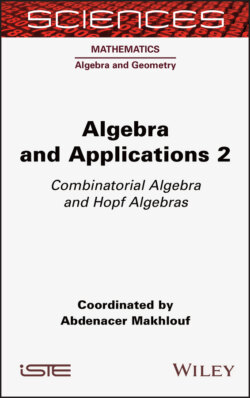Читать книгу Algebra and Applications 2 - Группа авторов - Страница 25
1.3.7. Renormalization in connected filtered Hopf algebras
ОглавлениеIn this section we describe the renormalization à la Connes-Kreimer (Connes and Kreimer 1998; Kreimer 2002) in the abstract context of connected filtered Hopf algebras: the objects to be renormalized are characters with values in a commutative unital target algebra endowed with a renormalization scheme, that is, a splitting into two subalgebras. An important example is given by the minimal subtraction scheme of the algebra of meromorphic functions of one variable z, where is the algebra of meromorphic functions which are holomorphic at z = 0, and stands for the “polar parts”. Any -valued character φ admits a unique Birkhoff decomposition:
where φ+ is an -valued character, and φ(Ker ε) ⊂ . In the MS scheme case described above, the renormalized character is the scalar-valued character given by the evaluation of φ+ at z = 0 (whereas the evaluation of φ at z = 0 does not necessarily make sense).
Here, we consider the situation where the algebra admits a renormalization scheme, that is, a splitting into two subalgebras:
with . Let be the projection on parallel to .
THEOREM 1.2.–
1 1) Let ℋ be a connected filtered Hopf algebra. Let be the group of those , such that endowed with the convolution product. Any admits a unique Birkhoff decomposition:
[1.30]
where φ− sends 1 to and Ker ε into , and φ+ sends ℋ into . The maps φ- and φ+ are given on Ker ε by the following recursive formulae:
[1.31]
[1.32]
1 2) If the algebra is commutative and if φ is a character, the components φ- and φ+ occurring in the Birkhoff decomposition of χ are characters as well.
PROOF .– The proof goes along the same lines as the proof of Theorem 4 from Connes and Kreimer (1998): for the first assertion, it is immediate from the definition of π that φ- sends Ker ε into , and that φ+ sends Ker ε into . It only remains to check equality φ+ = φ- * φ, which is an easy computation:
The proof of assertion 2 goes exactly as in Connes and Kreimer (1998) and relies on the following Rota–Baxter relation in :
[1.33]
which is easily verified by decomposing a and b into their -parts. Let φ be a character of ℋ with values in . Suppose that we have φ- (xy) = φ- (x)φ − (y) for any x, y ∈ ℋ, such that |x| + |y| ≤ d – 1, and compute for x, y, such that |x| + |y| = d:
with X = φ(x) – Σ(x) φ-(x′)φ(x″) and Y = φ(y) – Σ(y) φ – (y′)φ(y″). Using the formula:
we get:
hence:
We have to compare this expression with:
These two expressions are easily seen to be equal using the commutativity of the algebra , the character property for φ and the induction hypothesis. □
REMARK 1.2.– Assertion 2 admits a more conceptual proof (see the notes by Ebrahimi-Fard in the present volume), which is based on the following recursive expressions for the components of the Birkhoff decomposition: define the Bogoliubov preparation map as the map b : , recursively given by:
[1.34]
Then, the components of φ in the Birkhoff decomposition read:
[1.35]
The Bogoliubov preparation map also writes in a more concise form:
[1.36]
Plugging equation [1.36] into equation [1.35] and setting α := e − φ, we get the following expression for φ−:
[1.37]
[1.38]
where is the projection defined by P(α) = π ∘ α. The renormalizedpart φ+ satisfies an analogous recursive expression:
[1.39]
[1.40]
with β := φ1 * α = e – φ1, and where is the projection on defined by .
